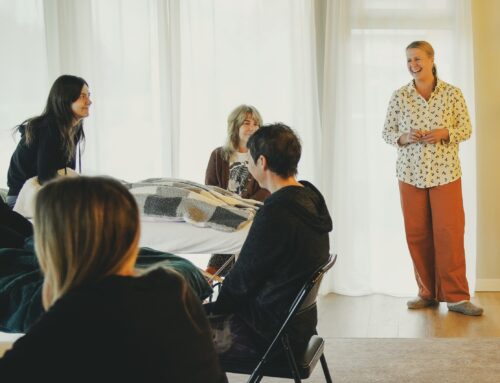Please review and understand my Covid-19 Safety Protocol before your visit. This plan outlines rules of conduct and expectations of clients as well as of myself, the practitioner, to reduce the risk of virus exposure to the virus that causes Covid-19.
The information in this document is to meet the requirements of the Ministry of Health (Guide for Personal Services), as well as meeting the requirements of malpractice and commercial liability insurers. These protocols will be continually updated to adhere to provincial health guidelines as they evolve.
This document is also posted on Isabel C. Lindemann’s website, and is subject to change. If changes are made to these guidelines the practitioner will inform you to review the document. This document will be made available to WorksafeBC or Public Health representatives upon request.
Current State of Knowledge
The BC Centre for Disease Control reports:
COVID-19 Transmission
Respiratory infections such as influenza (flu) and COVID-19 are mainly spread by liquid droplets that come out of the mouth and nose when a person with the virus breathes, coughs, sneezes, talks, or sings. Droplets come in a wide range of sizes, from smaller than the width of a hair to larger than a grain of sand. A few large droplets or many small droplets can contain enough virus to infect another person.
Droplet Sizes
Larger droplets are heavier, and they usually fall to the ground within two meters. The majority of COVID-19 infections are spread from one person to another through larger droplets. This is why maintaining physical distance, adding physical barriers, wearing masks, and hand hygiene are all important protective measures.
Smaller droplets come out of the mouth and nose at the same time as larger droplets. These smaller droplets are light, and they can float in the air for a longer time. Because of this, smaller droplets may collect in enclosed spaces unless they are diluted with clean air from the outdoors or from a ventilation system. If many people are sharing a space without enough clean air, it can lead to COVID-19 infections.
Surface Contact
Even though COVID-19 can survive for hours or days on different surfaces, infection from contact with contaminated surfaces appears to be less common. The most common type of spread is through larger droplets from close contact with an infected person.
There is no evidence that the virus transmits through food as it is destroyed almost immediately by stomach acid. Good hand hygiene is always important for food safety. For more information, see the BCCDC page on Food Safety and COVID-19.
Source: BC Centre for Disease Control. “How It Spreads.” Accessed February 20, 2021.
BC Centre for Disease Control adds specifically for physiotherapy, occupational therapy, massage therapy, dietetics, and chiropractic service:
“COVID-19 is most commonly transmitted through large droplets produced when a person infected with COVID-19 coughs or sneezes. The virus in these droplets can enter through the eyes, nose or mouth of another person if they are in close contact with the person who coughed or sneezed. The virus can also enter a person’s body from touching something with the virus on it and then touching one’s eyes, mouth or nose with unwashed hands.”
Source: COVID-19: Infection Prevention and Control Guidance for Community-Based Allied Health Care Providers in Clinic Settings Accessed February 20, 2021
Efforts to Reduce Transmission
The overall aim of these protocols is to reduce potential coronavirus transmission using the following methods:
- Screening: Require ongoing self-assessment for signs of Covid-19 related illness from both client and practitioner
- Distancing: Reduce all non-treatment related physical interactions amongst all people within the practice environment
- Hygiene: Hand hygiene requirements, avoiding face-touching, practice enhanced cleaning protocols, use appropriate use of personal protective equipment (PPE)
- Consent & Professional Obligations: Professional obligations, particularly related to informed consent and liability insurance
Screening
Pre-screening:
I’m making every effort to book high-risk-profile patients at very different times than those who are considered to have particularly vulnerable immune systems.
Please contact me before making an online booking if you are considered to have a vulnerable immune system or if you have a higher-risk-profile (those that work with Covid-19 populations, those that are listed as exempt from a travel-ban order, or distancing order).
If you have a weakened immune system you might want to consider postponing your appointment to reduce the risk to you.
- You are considered to be at higher risk if you are:
- over 70 years of age
- diabetic
- immunosuppressed
- undergoing treatment for cancer or pregnant
- suffering from cardiovascular disease
- more vulnerable to an existing condition of any kind
Before Arriving:
- 12 hours prior to your first booked appointment, please complete the COVID-19 Symptom Self-Assessment Survey and stay home if you are experiencing any symptoms of Covid-19.
- Before the initial appointment complete the intake form which includes a consent to receive treatment
- I have done all that I can to minimize the risk of transmission of Covid-19.
- For subsequent visits, I will communicate with you 12 hours before your appointment. These repeat verifications can be done by text or email.
- Your appointment must be cancelled immediately if either you or the practitioner presents with even mild symptoms that may be signs of Covid-19.
Symptoms of Covid-19 are similar to other respiratory illnesses and seasonal allergies. Including:
- – Fever
- – Cough
- – Chills
- – Shortness of breath/difficulty breathing
- – Sore throat or pain with swallowing
- – Stuffy or runny nose
- – Loss of sense of smell or taste
- – Headache
- – Muscle aches
- – Fatigue
- – Confusion
- – Loss of appetite
- – Diarrhea
- – Purple colored skin rash
- – Late cancellation fees due to illness will not be charged.
- – The late cancellation due to illness will be documented in your chart.
- – I will request that you phone 8-1-1 and speak with a health nurse at HealthLinkBC
Covid-19 Symptoms may range from mild to severe. You are required to cancel appointments if on the day of your appointment you develop symptoms or experience ‘just the sniffles’, ‘seasonal allergies’, or ‘just feeling under the weather’ types of symptoms. In such cases, the appointment should be cancelled even without notice.
As practitioner, I will use the BC COVID-19 Self-Assessment tool daily and commit to canceling all appointments if symptoms appear.
The nature of manual therapy means that within the treatment room physical distancing is not possible. In order for treatment to commence I, the practitioner and you must agree that the therapeutic benefit of therapy outweighs any potential risks or consequences of treatment, including the possibility of viral transmission.
You, as a client, must confirm that you have not:
- Been in contact with anyone displaying illness, or signs and symptoms of Covid-19 within 14 days prior to their treatment.
- Travelled outside British Columbia within 14 days prior to their appointment.
- You are not awaiting the results of a Covid-19 test or in the last month tested positive for Covid-19.
- If you were in quarantine, you must have completed it.
Upon Arrival:
- When you arrive here, please wash and sanitize your hands.
- I, the practitioner and you, the client will advise each other of our current Self-Assessment results for that day.
- I will document your temperature upon your arrival.
- The treatment will be cancelled immediately if we determine that you do not meet the pre-screening criteria upon physical presentation.
- Masks are required. If you have a mask, please bring it and wear it when you arrive and enter the house. If you don’t have a mask, I have single-use mask available for you.
Physical Distancing:
- Only 1 client per practitioner is permitted within the treatment room at any given time. Clients must arrive unaccompanied, unless it is a child with a guardian. Please make arrangements with me if you require mobility assistance.
- Practitioner and client are required to maintain a distance of 2 meters (6 feet) between one another in all other areas that are outside the treatment room.
- There is no waiting area. Appointment times are scheduled to reduce the likelihood of clients crossing paths, and to allow for time in-between sessions for enhanced cleaning.
- Clients are asked to arrive on time, no earlier than 5 minutes before their appointment.
- In an effort to minimize touchpoints, I will open the front door for the client at the time of entry, and will lock the door behind them to prevent anyone else from entering the space during the course of the treatment.
- All door handles and high touch points are sanitized between clients visiting for their appointment.
- There are no self-serve items or magazines available in the waiting area.
- The restrooms, located outside of the office and at the main entrance are cleaned after every use.
- Soap and fresh paper towels for drying are available at all times in the washrooms.
Hygiene:
- Immediately upon entering the clinic space the patient will be invited to either: Go directly to the sink and wash your hands with soap and water for at least 20 seconds and then dry thoroughly.
- Or, use the hand sanitizer dispenser offered to you.
- If hands are visibly soiled, the client must opt to wash hands at the hand-washing sink.
- Please, minimize touching of objects in the clinic space (including plants, ledges, and walls); all surfaces and objects touched by the client will be sanitized between treatments.
- Door handles will be sanitized after every appointment.
- The practitioner will wash hands thoroughly for at least 20 seconds between clients, before and after disinfecting spaces, and before donning or doffing PPE like gloves, face-masks, or shields.
- Hand washing protocols will be posted visibly.
Head and face treatment:
- In manual therapy with an osteopathic approach, head and face might be touched
- Face masks remain in place.
- I will request your verbal consent to work on your face
Payment:
- I prefer card payments to avoid handling cash. You can also e-mail transfer me.
- All receipts will be emailed, I do not provide paper copies.
Cleaning Protocol:
- I scheduled additional time between clients to allow for thorough cleaning of the treatment room, washrooms, and entry.
- Surfaces will be cleaned and disinfected using Canada Health Approved cleaning guide for public space.
- All high-touch surfaces will be cleaned and disinfected between clients, regardless of appearances. High-touch surfaces include (but are not limited to):
- – light switches
- – door knobs
- – electronic devices
- – table surfaces
- – chairs
- – stools
- – window coverings
- – faucets
- – treatment table
- – table levers
- – face cradle
- A disinfected single-use plastic bin has been placed in the treatment room. You will be asked to keep all of your personal belongings in this bin during the treatment. Bins will be disinfected between each client before cycling back into use.
Personal Protective Equipment:
- Provincial Health guidelines require wearing a mask in situations where social distancing is not possible.
- Masks: In order to forgo social distancing, it is required that all parties wear a mask. Cloth or disposable paper masks are acceptable, medical grade is not a necessity.
- I ask that clients wear a face-mask that covers both the nose and mouth at all times.
- I, the practitioner will wear a disposable mask at all times, and change masks after every client.
- I, the practitioner will wear a face-shield if you request it.
- I, the practitioner will wear non-latex gloves if/when appropriate.
- Gloves may be appropriate when my hands or skin of the hands are otherwise injured, or when over-use of cleaning and/or chemicals causes skin irritation.
- I, the practitioner will wear gloves at your request.
- I, the practitioner will change clothes (top and bottom) after each client.
Consent (Professional Obligations) Asymptomatic Spreaders:
Asymptomatic transmission of the coronavirus is an unavoidable risk of practice until we’ve acquired herd immunity, or there is effective treatments or available vaccine against Covid-19.
Informed Consent:
Regarding current Covid-19 risks, informed consent requires that you, the client is informed and understands that:
- Any manual therapy treatment involves some risk of Covid-19 transmission
- The practitioner is following protocol to help reduce or mitigate risk where possible, but that risk cannot be reduced to zero
- The client consents to the treatment despite some risk
- For initial appointments following this protocol, I require a signed consent form that will be attached to your file. At every subsequent treatment, we will verbally re-confirm that nothing has changed for either party regarding the consent agreement, and the verbal consent will be documented in the clients file.
- Covid-19 Specific Consent requires clients to understand that while I’ve taken all possible measures to minimize risk of viral transmission, there is the possibility of coronavirus-related risks associated with your visit. The client releases the practitioner, clinic, and additional insured parties from any and all liability related to coronavirus exposure or sickness.
Insurance:
- My insurance provider has informed me that coverage for client claims concerning coronavirus exposure related to a visit to my clinic does not exist, the client must understand there is risk of coronavirus exposure, and the client agrees to assume that risk when visiting Isabel C. Lindemann for manual therapy.
- In the event that a client alleges they caught Covid-19 from the practitioner or if the practitioner is informed a client received treatment and has Covid-19 (asymptomatic at time of treatment):
- The practitioner will immediately call public health at 8-1-1 to report the event, providing both the name of the practitioner and the name and contact details of the client.
- The client must agree to the release of this information in this circumstance in order to receive treatment.
- All appointments will be cancelled and the practitioner will cease to provide services until Public Health has investigated and provided direction.
- The practitioner will immediately self-isolate until Public Health has investigated and provided direction.
- I have put into place protocols to help mitigate that risk as outlined in the preceding documentation.
Liability Insurance:
Isabel C Lindemann carries professional liability insurance through Lacker McLennan Insurance Ltd.




